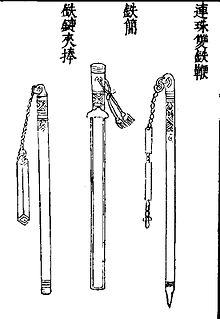
The jian is a double-edged straight sword used during the last 2,500 years in China. The first Chinese sources that mention the jian date to the 7th century BCE, during the Spring and Autumn period; one of the earliest specimens being the Sword of Goujian. Historical one-handed versions have blades varying from 45 to 80 centimeters in length. The weight of an average sword of 70-centimetre (28-inch) blade-length would be in a range of approximately 700 to 900 grams. There are also larger two-handed versions used for training by many styles of Chinese martial arts.

A club is a short staff or stick, usually made of wood, wielded as a weapon since prehistory. There are several examples of blunt-force trauma caused by clubs in the past, including at the site of Nataruk in Turkana, Kenya, described as the scene of a prehistoric conflict between bands of hunter-gatherers 10,000 years ago.
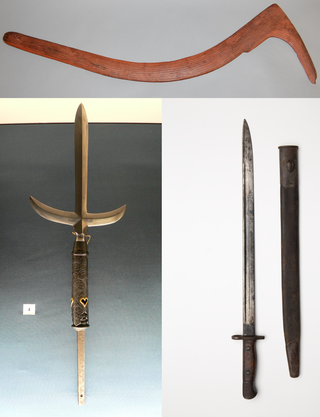
A melee weapon, hand weapon or close combat weapon, is any handheld weapon used in hand-to-hand combat, i.e. for use within the direct physical reach of the weapon itself, essentially functioning as an additional extension of the user's limbs. By contrast, a ranged weapon is any other weapon capable of engaging targets at a distance beyond immediate physical contact.
The different slow motion solo form training sequences of tai chi are the best known manifestation of tai chi for the general public. The forms are usually performed slowly by beginners and are designed to promote concentration, condition the body and acquaint students with the inventory of motion techniques for more advanced styles of martial arts training. There are also solo weapons forms, as well as much shorter and repetitive sequences to train power generation leverages. The postures of the laojia yi lu listed below is the "old frame, first routine" of the Chen-style with focus on silk reeling.
Dugu Qiubai is a fictional character who is mentioned by name in three wuxia novels by Jin Yong. He does not appear directly in any of the novels because he lived in an era long before the events of the novels took place. Nicknamed "Sword Devil" to reflect his prowess in and devotion to the practice of swordplay, he attains the philosophical level of "swordsmanship without a sword", which means that he uses swordplay techniques in combat without the physical existence of a sword.
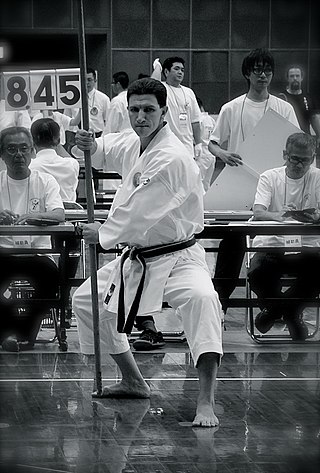
Okinawan Kobudō (沖縄古武道), literally "old martial way of Okinawa", is the weapon systems of Okinawan martial arts.
The Kabutowari, also known as hachiwari, was a type of knife-shaped weapon, resembling a jitte in many respects. This weapon was carried as a side-arm by the samurai class of feudal Japan.
Taijijian is a straight two-edged sword used in the training of the Chinese martial art tai chi. The straight sword, sometimes with a tassel and sometimes not, is used for upper body conditioning and martial training in traditional tai chi schools. The different family schools have various warmups, forms and fencing drills for training with the jian.

The Eighteen Arms is a list of the eighteen main weapons of Chinese martial arts. The origin of the list is unclear and there have been disputes as to what the eighteen weapons actually are. However, all lists contain at least one or more of the following weapons:
The tekkan, also known as tetsu-ken or tettō, is a Japanese weapon that was used during the Edo period until the beginning of the 20th century. It was an iron truncheon; it could closely resemble a wakizashi-sized sword with a blunt iron blade, or it could be a cast-iron version of a kabutowari.
Historically, Chinese swords are classified into two types, the jian and the dao. A Jian is a straight, double-edged sword mainly used for stabbing, and has been commonly translated into the English language as a longsword; while a dao is a single-edged sword mainly used for cutting, and has been translated as a saber or a "knife".
The jian is a double-edged straight sword used during the last 2,500 years in China.

Listed here are the weapons of pencak silat. The most common are the machete, staff, kris, sickle, spear, and kerambit. Because Southeast Asian society was traditionally based around agriculture, many of these weapons were originally farming tools.
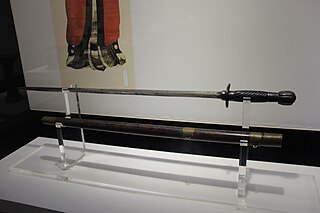
An assassin's mace is a legendary ancient Chinese weapon. It is now used metaphorically to describe certain Chinese weapons systems. The term has its roots in ancient Chinese folklore, which recounts how a hero wielding such a weapon managed to overcome a far more powerful adversary. The eponymous assassin's mace was a club which was used to break an enemy's blade in combat, or a hand mace that could impact through an enemy's armor. According to American military analysts, the term is now used in China to describe a specific type of military system that demonstrates asymmetrical warfare and anti-access/area denial capabilities to counter the United States. Whether assassin's mace refers to a government-defined class of weapons or is merely used in the Chinese government to describe these weapons is disputed.

A gun or bang is a long Chinese staff weapon used in Chinese martial arts. It is known as one of the four major weapons, along with the qiang (spear), dao (sabre), and the jian. It is called, in this group, "The Grandfather of all Weapons". In Vietnam, the gun is known as côn in Vietnamese martial arts.

The three-section staff, three-part staff, triple staff, originally sanjiegun or sansetsukon, three-section whip, originally sanjiebian, is a Chinese flail weapon that consists of three wooden or metal staffs connected by metal rings or rope. The weapon is also known as the coiling dragon staff, originally panlong gun. A more complicated version of the two section staff, the staves can be spun to gather momentum resulting in a powerful strike, or their articulation can be used to strike over or around a shield or other defense.

The tekpi is a short-handled trident from Southeast Asia. Known as tekpi in Malay, it is called chabang or cabang in Indonesian, siang tépi in Hokkien, and trisul in Thai. More than a weapon, it was also important as a Hindu-Buddhist symbol. It is comparable to the Okinawan Sai.
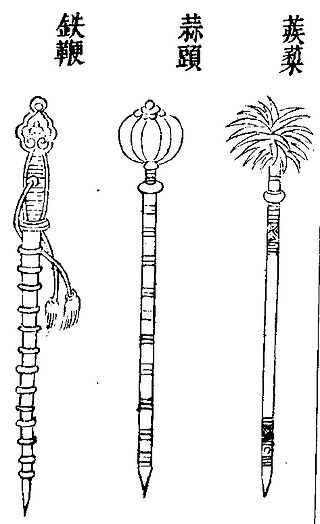
The bian or tie bian and gang bian, also known as Chinese whip or hard whip, is a type of tubular-shaped club or rod weapon designed to inflict blunt damage with whipping motion.
